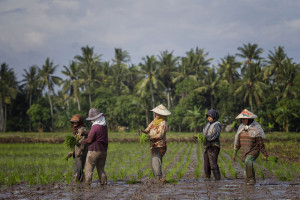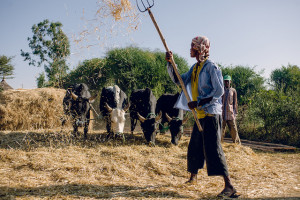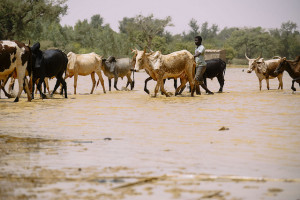A new framework helps countries assess whether to cut emissions from forestry or agriculture.
By Samuel Mcglennon, originally posted at CIFOR’s Forests News

The most promising interventions to reduce emissions in tropical forest-rich countries like Indonesia, Brazil and the Democratic Republic of the Congo (DRC) may not lie in the forest at all.
Instead, those interventions might be right under our noses—in the food on our plates.
This is because, as scientist Sarah Carter puts it, you cannot separate forests and agriculture.
“To look after forests, you have to look hard at agriculture,” said Carter, the lead author of a study on reducing emissions from agriculture, from the Center for International Forestry Research (CIFOR).
“And agriculture means the food we eat, and how and where it is produced,” she added.
Motivated by this well-evidenced conclusion, Carter and other CIFOR scientists embarked on a pantropical study to canvas and compare the potential emission reductions of interventions in the agricultural and forest sectors.
Land sparing or land sharing
The study is premised on the concept of “land sparing”, whereby deforestation or other pressure on forest can be either averted—by maximizing agricultural yields to minimize the area of land required—or diverted toward non-forest lands.

“One approach is to intensify agriculture to produce more on existing land, which would mean there would be less need to expand agriculture land into forests,” Carter said.
“The other approach is to expand agriculture into areas other than forests, by rehabilitating degraded pasture lands, for example. This is already quite a focus in international discussions.”
Both of these approaches have long been recognized as not only possible but also necessary to conserve forests while feeding a growing global population.
A novel aspect of the study is that it encompasses both agricultural and deforestation sources of emissions. The research accounts for the fact that in some countries, agricultural emissions are higher than deforestation emissions.
“You have to look at the balance of emissions from both agriculture and forestry to determine whether you should address agriculture emissions or deforestation emissions in a country,” Carter said.
In the study, Carter and her co-authors quantified potential emission reductions from agriculture-driven deforestation. They found that interventions in just the 20 most promising countries could mitigate almost one-third (1.3 Gt of 4.3 Gt) of these emissions.
The authors found that a further 1 Gt of direct emissions from agriculture could be mitigated by interventions that make that sector “climate smart”.
Farms or forests?
Carter and her co-authors wanted to make it as easy as possible to find spaces to reduce emissions in developing countries. In what is another novel contribution of the study, they developed a framework to guide each country in deciding whether the agriculture or forest sector might offer the biggest reductions.

The framework adds further nuance through a set of filters designed to help policymakers assess other important factors in the quest for emissions reductions.
“In countries with high food insecurity, such as the DRC, you would need to be careful if you were looking to make interventions that are going to affect the agricultural sector and potentially affect livelihoods,” Carter says.
“On the other hand, in countries with low food insecurity, like Argentina and Indonesia, it might be easier to go ahead with agricultural interventions.”
Another factor is whether the country has a supportive environment for interventions, using good governance as a proxy.
Bringing agriculture into REDD+
Governance is particularly important given the study’s suggestion that agricultural interventions be given more national and international prominence under the REDD+ framework.
REDD+, or Reducing Emissions from Deforestation and forest Degradation, is an ongoing international effort to develop and fund projects for reducing emissions related to forests in developing countries.
The framework was agreed upon in mid-2015, after a decade of negotiations, just in time for the UNFCCC Conference of the Parties (COP) climate negotiations in Paris.
Under REDD+, countries propose projects and generate verifiable “credits” from avoided emissions, which are then purchased to offset emissions incurred elsewhere.

“It’s widely recognized that agriculture is the main driver of deforestation in tropical countries, but that somehow hasn’t filtered up into national-level project proposals under REDD+,” said Carter.
“The vast majority of proposed REDD+ projects are still focused on the forest sector, neglecting the agricultural sector. So there’s obviously a kind of mismatch right now.”
Carter is optimistic that this readjustment will eventually be made.
“Maybe it’s something that is going to grow in the future, and hopefully the findings from this study and other studies will really highlight the need to include agricultural interventions in REDD+,” she said.
To truly protect forests, the findings suggest, researchers and policymakers must all be willing to acknowledge and intervene in the broader landscape of which they are a part, a landscape that—perhaps most crucially—includes agriculture.
In other words, there’s a need to see not just the forest for the trees, but also the landscape for the forest.











